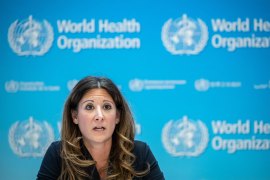WICHITA – Kansas is going to need more doctors to meet the growing needs of an aging population, officials here say.
Meanwhile, the University of Kansas School of Medicine in Wichita has been successful training doctors who choose to remain in the state.
Almost half its graduates have stayed in Kansas; the national average for retaining medical school graduates is 29 percent.
With the aim of turning out more graduates, university officials here have long wanted to convert the Wichita campus to a four-year school. It’s a two-year program, now.
“I think we could produce more doctors in Kansas and the most likely place for that to happen is in Wichita,” said Dr. H. David Wilson, dean of the Wichita campus since July 1, 2009. “We could more than double the number of medical students we have now.”
Wilson has proposed taking on as many as 28 first-year students as early as next fall and 28 more in the fall of 2012.
By 2014, he’s hoping to have 50 first-year, 50 second-year, 75 third-year, and 75 fourth-year students.
Today, the school has 110 students — 55 in their third year, 55 in their fourth year.
In Kansas, first- and second-year medical students are trained at the KU School of Medicine in Kansas City.
Wilson, who came to Wichita from the University of North Dakota School of Medicine, said he’s in the “very initial stages” of meeting with private donors who could perhaps help cover the costs of the initial expansion. Tuition income, too, will help cover the costs.
“We recognize the state doesn’t have the money to support this activity at this time,” he said.
Wilson declined to say how much the expansion is expected to cost but noted it does not include a new building.
Wichita and the medical school, Wilson said, are well-suited for the expansion.
“We certainly have the medical facilities, the patient base and a large number of physicians who are willing to help educate medical students,” he said. “And I’m working closely with Wichita State University so that we won’t have to duplicate the science education and research components that are going on in Kansas City.”
The two largest hospitals in Kansas Via Christi Health System and Wesley Medical Center are in Wichita.
The city also has more than a thousand practicing physicians.
The plan includes the Wichita campus having ready access via video conferencing to classes taught on the Kansas City campus. Also, lectures are routinely podcast and available to students.
But at some point, the expansion’s success will depend on state funding.
“Absolutely,” Wilson said. “We can do this on tuition and good will private support – for a couple years, maybe three. But ultimately for us to produce more doctors for Kansas we’ll have to have the state’s help. It needs to be a partnership.”
In conjunction with the move to a four-year curriculum, Wilson wants to institute what is called patient-centered learning, a concept he helped pioneer in North Dakota.
“It’s a wonderful way to educate students,” he said. “They start out with real patient cases. They’re shown the way physicians use basic science to diagnose and treat and then on Fridays they actually meet and have a dialogue with the individual they’ve been studying.
“It’s not theoretical,” Wilson said. “It’s a real physician in front of the class talking about how the diagnosis was made and how treatment was instituted. And then the students have a chance to question the patient. What did they think? How did this affect you? How did it affect your family? How much did it cost? What do you think of the health care system?
“It’s a much more spirited, much more adult way to learn rather than the rote memorization we have now,” he said.
The Kansas Medical Society welcomes Wilson’s efforts.
“This discussion isn’t new there’s been talk about having a four-year medical school in Wichita for quite some time,” said Jerry Slaughter, executive director of the society. “What’s different now, I think, is people are starting to see that with health reform if there is health reform there’s going to be a significant reduction in the number of uninsured in this country, which is going to cause an increase in demand for services because these are people who for the most part aren’t accessing services now. And this is on top of the demographic thing with the population aging and physicians retiring.”
To some observers, Slaughter said, wanting to expand a medical school in the midst of a recession and state cutting appears futile.
“But the discussion needs to be going on now,” he said. “The vision needs to be there. People seem to forget that it takes seven to eight years minimum to produce a primary care specialist four years of school, three to four years of residency. You can’t just turn the tap and start producing them.”






